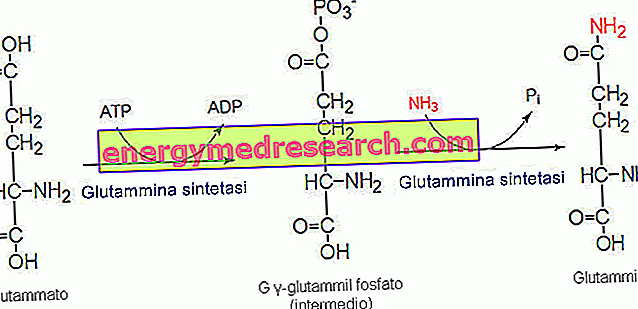Generality
Parakeratosis is a disorder that influences the maturation and differentiation process of epidermal cells.

This alteration is characterized, in particular, by an excessive thickening of the stratum corneum . The cells that make up this part of the epidermis retain their nucleus, unlike what normally happens in the most superficial layers of the skin. In parakeratosis, this phenomenon results in a scaly, shiny and keratinized appearance of the skin and mucous membranes.
Parakeratosis is a condition that mainly affects the dermatological field, being a typical manifestation of psoriasis and various forms of dermatitis . Usually, the presence of this anomaly indicates that the epidermis has been repeatedly exposed to an inflammatory and / or irritative stimulus .
Treatment of parakeratosis varies depending on the underlying disease.
What's this
Parakeratosis is a disorder of keratinization, in which a reversal of the normal epidermal maturation process occurs.
In practice, the direct passage of the cells from the thorny layer to the horny layer occurs; consequently, all the intermediate steps of normal differentiation are not observed in parakeratosis.
It should be remembered, in fact, that the epidermis is made up of different "zones" (from the deepest layer to the surface: basal, thorny, grainy, shiny and horny ) that reflect the life cycle of the epithelial cells present: the keratinocytes .
Note . Keratinocytes are the most superficial cells of the epidermis, whose name derives from the protein they contain: keratin . The keratinocytes are born from the germinative layer and gradually rise to the surface; during the journey, these elements undergo a degeneration that ends with terminal differentiation (that is, with the death of the cells) and peeling of the skin .
In parakeratosis, the cells of the stratum corneum thus retain their nucleus, while the granular layer appears reduced or even disappears. This results in thickening of the skin and in the increased tendency of the same to flake .
How the skin is made (in short)
The skin appears as a thin fabric, covered with hair and small imperfections. In reality, this is composed of three main layers, each of which performs different functions and, in turn, are divided into further zones:
- Epidermis (most superficial layer): it is the epithelial layer of the skin, which represents the external scaffold of this organ. Here are the germinative cells involved in the production of all the skin components.
- In the epidermis, the stratum corneum is about three-quarters of the epidermis; it is formed from 20 to 30 cellular lamellas, which resemble overlapping "tiles" ("horny scales") which determine the keratinization of the skin and its protection. The cells that form these laminae have no nucleus and have a hard consistency; each of these elements is destined to detach and fall through desquamation, to then be replaced by new cells.
- Derma (intermediate part): it is formed by connective tissue, soft and elastic. The dermis is crossed by capillaries, lymphatic vessels and nerve receptors (papillary layer). Furthermore, this portion allows the skin to remain elastic and tight, allowing adequate protection of the whole body (reticular layer).
- Hypoderm or subcutaneous (innermost layer): it connects the dermis and the epidermis to the internal tissues, allowing the anchorage on muscles and bones and favoring the adherence of the skin during the movement of the body.
Causes
Parakeratosis can be one of the consequences of morbid dermatological or systemic events . In particular, this alteration of keratinization is found in numerous conditions, in which there is an increase in cell turnover, be it inflammatory or neoplastic.
Keratinization disorders: what are they?
The anomalies of the keratinization process are a group of skin diseases that involve the stratum corneum, ie the most superficial part of the skin.
For simplicity, these pathologies are classically divided into:
- Quantitative, such as hyperkeratosis (a condition in which keratinocyte proliferation is increased);
- Qualitative, such as dyskeratosis and parakeratosis .
Parakeratosis: what changes occur?
- Parakeratosis is a disorder of keratinization characterized by an abnormal cellular maturation, which involves the presence of particular nuclear structures within the elements of the most superficial layer of the skin ( stratum corneum ). Paracheratotic nuclei are pyknotic (in cytology, this characteristic is indicative of a degenerative process ) and often elongated, regardless of the underlying disease.
- The persistence of the cell nucleus in the keratinocytes results in the thickening of the stratum corneum, ie in an increase in the thickness of the cells of the superficial layer .
- At the same time, in the parakeratosis the reduction or absence of the granular layer is found : the skin becomes so scaly.
- The incomplete keratinization is a consequence, in general, of an inflammation or chronic irritation, consequent to the exposure of infectious, mechanical and chemical stimuli .
Parakeratosis: what are the pathologies in which it manifests itself?
Parakeratosis generally occurs in response to phlogistic events (as happens, for example, in the case of psoriasis), infections, irritative stimuli and metabolic disorders .
In the dermatological field, this phenomenon is observed in all diseases that involve an acceleration of cellular maturation processes .
Parakeratosis occurs most commonly in the context of:
- Psoriasis : is an erythematous-desquamative dermatosis, characterized by abnormal corneification and strongly increased epidermal mitotic activity. The typical lesions of psoriasis are well-defined plaques, pink or red, hidden by numerous whitish, glossy, dry and friable scales. These occur mainly on the elbows, knees, sacro-lumbar region and trunk; rarely, on the face and scalp.
- Seborrheic dermatitis : it is a frequent skin condition, supported by a metabolic disorder. Parakeratosis occurs in the form of erythematous plaques with fatty scales. The manifestations of seborrheic dermatosis are localized at the scalp, eyebrows, nose-genital and retro-auricular grooves, external auditory ducts and mid-sternal region.
Other conditions in which parakeratosis is found are:
- Stasis dermatitis : parakeratosis occurs mainly at the level of the legs and is associated with the formation of scales and ulcerations;
- Chronic eczema : parakeratosis forms over areas of spongiosis (intercellular edema of the spinous layer of the epidermis, which is soaked in serum), probably as a result of an acceleration in the movement of keratinocytes towards the surface.
Outbreaks of parakeratosis are also observed in the presence of:
- Atopic dermatitis (atopic eczema);
- Contact dermatitis ;
- Chronic lichen simplex (form of neurodermatitis);
- Prurigo nodularis (dermatological disease characterized by itchy nodules);
- Dyshidrosis (dyshidrotic eczema);
- Dandruff .
Parakeratosis can also occur in malignant skin cancers (such as squamous cell carcinoma).
Leather, but not only
- As anticipated, parakeratosis mainly affects the dermatological field. This condition is relatively common in both benign and malignant skin diseases.
- Parakeratosis is useful for classifying some forms of dermatitis and represents a morphological characteristic useful for the differentiation of inflammatory skin diseases .
- Its diagnostic value in the distinction between benign lesions and malignancies has not yet been sufficiently investigated; with regard to nuclear morphology between benign and malignant parakeratosis, on the other hand, a fairly consistent difference was found.
- This event, however, is also found in gynecology and dentistry . Parakeratosis is a normal phenomenon in squamous mucous membranes (such as the oral mucosa).
Symptoms
In the presence of parakeratosis, there is a series of dermatological manifestations. In particular, the superficial layers of the skin and mucous membranes take on a thickened, whitish and keratinized appearance . Parakeratosis is the basis of scales formation .
Diagnosis
Parakeratosis should be appropriately evaluated by a doctor specialized in dermatology. Diagnosis may involve the collection of personal and family history data and physical examination of the area of skin or mucous membranes involved.
Usually, the definition of parakeratosis requires a skin biopsy .
Treatment
The therapeutic approaches to parakeratosis are different depending on the type of underlying pathology to be treated.
In general, the strategies available to remedy the problem are based mainly on three action interventions:
- Topical drugs : it is a type of treatment that is chosen when the disorder concerns a limited area of the body. These medicines must be applied locally, at the point of cutaneous manifestations;
- Systemic drugs : they are administered based on the extent of the disease; the use of these medicines is indicated when the parakeratosis and the manifestations associated with it are widespread and simultaneously concern more districts of the body;
- Phototherapy : artificial sources of UVA and UVB rays are used, specifically calibrated for the individual case.
In any case, it is advisable to follow only the instructions provided by the dermatologist or your primary care physician. Parakeratosis should be monitored at a rate established by the clinician (for example, every six to twelve months), so as to always keep the progression of the lesions under control.



